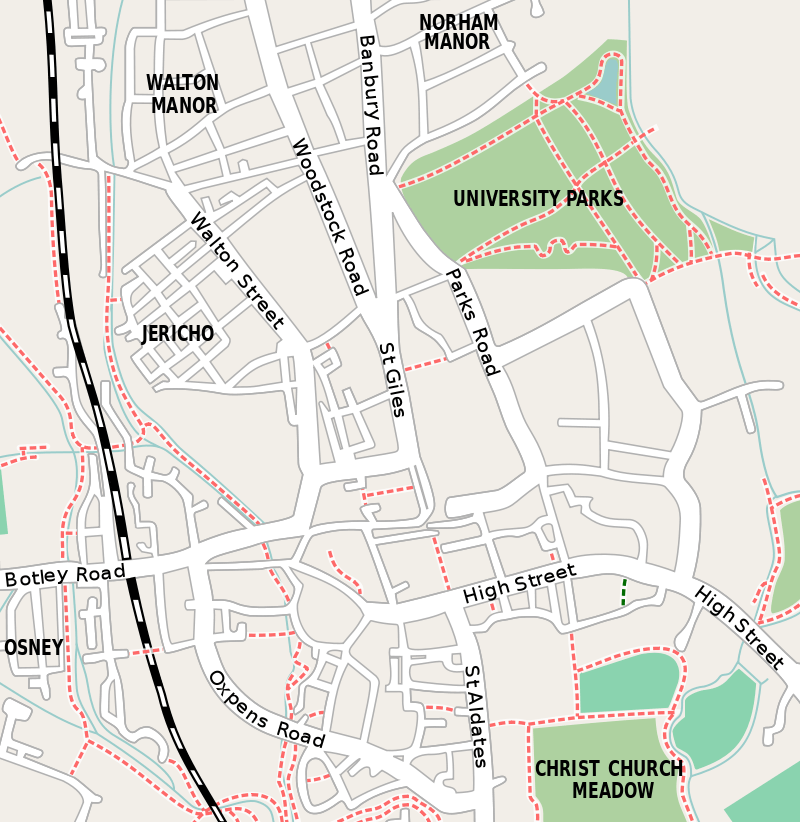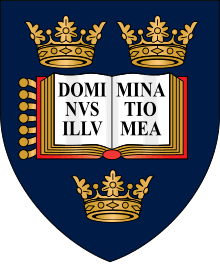St Cross College, Oxford
| St Cross College | ||||||||||||||||
|---|---|---|---|---|---|---|---|---|---|---|---|---|---|---|---|---|
| Oxford | ||||||||||||||||
 | ||||||||||||||||
 Blazon: Argent a Cross Potent Purpure a Quarter counterchanged;
and for the Crest upon a Helm with a Wreath Argent and Purpure an Armillary Sphere upon a Stand Or thereon a Dove with wings elevated and displayed Argent holding in the beak a Sprig of Mulberry fructed and leaved proper mantled Purpure doubled Argent[1] | ||||||||||||||||
|
| ||||||||||||||||
| Location | St Giles' | |||||||||||||||
| Coordinates | 51°45′24″N 1°15′37″W / 51.756528°N 1.260311°WCoordinates: 51°45′24″N 1°15′37″W / 51.756528°N 1.260311°W | |||||||||||||||
| Latin name | Collegium Sanctae Crucis Oxoniae | |||||||||||||||
| Motto | Ad quattuor cardines mundi | |||||||||||||||
| Established | 1965 | |||||||||||||||
| Named for | St Cross Road and St Cross Church[2] | |||||||||||||||
| Sister college | Clare Hall, Cambridge | |||||||||||||||
| Master | Carole Souter CBE | |||||||||||||||
| Undergraduates | 0 | |||||||||||||||
| Postgraduates | 492 (2011/2012) | |||||||||||||||
| Visitor | The Lord Mance as High Steward of the University of Oxford | |||||||||||||||
| Website |
stx | |||||||||||||||
| Boat club | Boat Club shared with Wolfson College Boat Club | |||||||||||||||
| Map | ||||||||||||||||
 Location in Oxford city centre | ||||||||||||||||
St Cross College is a constituent college of the University of Oxford in England. Founded in 1965, St Cross is the fourth youngest of Oxford's 38 colleges. It is an all-graduate college with traditional-style buildings on a central site in St Giles', just south of Pusey Street. It aims to match the structure, life and support of undergraduate colleges, with the relaxed atmosphere of an all-graduate college.[3]
In May 2016, it was announced that the Fellows of St Cross College had elected Carole Souter CBE, Chief executive of the National Heritage Memorial Fund and Heritage Lottery Fund, as the next Master of the College. In September 2016, she succeeded Sir Mark Jones, who had been Master of St Cross since 2011.[4]
History
St Cross College was formally set up as a society by the University on 5 October 1965; it was to admit its first graduate students (five in number) in the following year. Like the majority of Oxford's newer colleges, St Cross has been coeducational since its foundation.[5]
The early location of St Cross was on a site in St Cross Road, immediately south of St Cross Church. The college was named for its proximity to these places. In 1976 negotiations began between the college and the members of Pusey House over the possibility of moving the college to the St Giles site. The negotiations were successful, and in 1981 the college moved from St Cross Road into a site owned by Pusey House for a leased period of 999-years. The old site on St Cross Road continued to be used, initially by the Centre for Islamic Studies (at that time an Associated Centre of the college), and then subsequently in the early 1990s the site was developed by the college in collaboration with Brasenose College. The site now houses two residential buildings, which were opened in 1996.
On 18 November 2010, it was announced that Sir Mark Jones, previously Director of the Victoria and Albert Museum, had been elected as the next Master of the college; he took up the post in September 2011.[6] Unlike every other college head (except the President of Kellogg), the Master of St Cross is appointed not by the college's governing body but by the University Council.[7] Therefore, the election has only the character of a recommendation to Council, albeit one which is constantly followed.
Buildings
The college is located on St Giles near to the Ashmolean Museum, and immediately north of Blackfriars. It is also within metres of the Classics faculty and the Oriental Institute. Regent's Park College, one of Oxford's Permanent Private Halls, is also nearby.
The college buildings are structured around two quads, the Richard Blackwell Quadrangle and the new West Quad. St Cross shares the site with Pusey House, which comprises the first floor and parts of the ground floor to the eastern side of the Blackwell quad, a library on the first floor on its western side, as well as the chapel. The original Pusey House buildings around the Blackwell quad, including the chapel, date from the period of 1884 to 1926 and are mainly the work of the architects Temple and Leslie Moore and Ninian Comper. Discreet internal alterations were made when St Cross moved in by Geoffrey Beard and the Oxford Architects Partnership. Among these was the conversion of a cloister and store rooms into the Saugman Hall (now the Saugman Common Room) named after Per Saugman, a former Director of Blackwell Scientific Publications and a former fellow of the college. The first quadrangle was named the Richard Blackwell Quadrangle in honour of Richard Blackwell (another former fellow); both Saugman and Blackwell played a crucial part in securing for St Cross the large Blackwell benefaction for the college. Most students, however, used to refer to the Richard Blackwell Quadrangle by its nickname: 'the Quad'. After completion of the second quad, it is now commonly known as 'the front Quad'.
At the west side of the Blackwell Quad lies the Four Colleges Arch, named after the four colleges which had contributed especially generous capital and recurrent funding to St Cross: Merton, All Souls, Christ Church, and St John's.
Behind the Four Colleges Arch originally lay a large open garden bordered by medieval boundary wall. This has offered the college the possibility of expanding its buildings and erecting a second quadrangle, the West Quad.
Work was first completed on the South Wing On the southern side of the West Quad, containing a hall and kitchen, with bar, the Ian Skipper conference room, and the Caroline Miles games room below, a guest room and study bedrooms above. This development has in part been financed by Ian Skipper, Domus fellow of the college, after whom the conference room on the lower ground floor was named.[8]
A second building to the western and northern sides of the West Quad was set to be completed in time for the college's semicentennial in 2015.[9] However, planning permission for the new building was rejected, as it required the demolition of a medieval boundary wall, an action which the council qualified as 'unjustifiable'.[10] Planning permission was subsequently granted following an appeal,[11] and the new West Wing building was completed in 2017.[12] The new West Quad includes 50 new student bedrooms, a new lecture theatre, a library with a garden room (the Douglas and Catherine Wigdor Library), several new seminar rooms, and the Audrey Blackman Guest Room.[13]
In addition to the current main site, the college still owns its original site on St Cross Road, located near the Law Faculty. After the college moved to its present location, this site was developed into student accommodation, the St Cross Annexe.
Additional buildings which are run by St Cross College as student accommodation include Bradmore Road House, Stonemason House, and the Wellington Square houses.[14]
Furthermore, the master's lodgings are also located in Wellington Square.
Academia
In 2016, St Cross had over 550 graduate students, studying for degrees in all subjects.[15] There is a strong emphasis on international diversity, with regularly over 75% of the students coming from outside the UK (2016: 83%[16]). This is reflected in the college motto Ad quattuor cardines mundi, meaning 'to the four corners of the earth'. The fellowship is similarly diverse and represents a broad range of academic disciplines in the sciences and the arts.
The college awards a number of scholarships in different subjects, predominantly in the humanities and social sciences.[17]
Unusually for an Oxford college, there is a founding tradition of sharing social facilities between fellows, members of Pusey House, the Common Room and students, with no separate high table or Senior Common Room. This gives the college a much more informal atmosphere and makes it an important community of scholars who forge links across a range of subjects.
The college has an active social calendar for both current students and alumni. There are a range of college societies and sports teams (often in collaboration with other colleges), as well as weekly academic seminars and annual conferences.
The college's Boat Club, shared with Wolfson College is particularly successful, and like many other college boat clubs competes both within the university itself and in external competitions.[18] The St Cross women's football team also enjoys success, becoming Cuppers Champions in 2015.[19]
Other events in the college include regular feasts, 'bops' and balls. As a result of the large international community at St Cross, the college strives to cater a wide range of events from other cultures; St Cross was the first Oxford college to officially celebrate Chinese New Year.[20] Reunion events for alumni are hosted by the college annually both in Oxford itself and abroad.[21]
Administration
Together with Kellogg, St Cross is the only Oxford college without a royal charter. It is officially a society of the university rather than an independent college.[22] The main difference from an independent college is that the governing body only recommends a Master, who is then appointed by Council; in other colleges, the head of house is elected and appointed by the governing body directly. For accounting purposes, both societies are considered departments of the university.[23] St Cross has one of the smallest endowments of any Oxford college, at approximately £8 million.[24] Nevertheless, the college has several scholarships that it awards to current and prospective graduate students and that are funded by third party donations and alumni.[25]
Traditions
Grace
The College grace is:
| “ | (ante cibum) Adesto nobis, Domine Deus noster: et concede ut quos Sanctae Crucis laetari facis honore, ejus donis quoque salutaribus nutrias, per Dominum nostrum Jesum Christum.
(before the meal) "Be present with us, O Lord our God: and grant that those whom thou makest to rejoice in the honour of the Holy Cross, thou mayest also nourish by wholesome gifts, through our Lord Jesus Christ." |
” |
| “ | (post cibum) Gratias agimus tibi, Domine, pro omnibus beneficiis tuis per Dominum nostrum Jesum Christum.
(after the meal) "We give thanks to thee, O Lord, for all thy favours through our Lord Jesus Christ." |
” |
Notable alumni
- Sultan Muhammad V, Sultan of the Malaysian state of Kelantan and 15th Yang di-Pertuan Agong of Malaysia
- Aharon Appelfeld, Israeli novelist
- Steve Baker, British politician
- Ruth Barnes, academic and curator of the Ashmolean Museum and Yale University Art Gallery
- Christian M. M. Brady, academic at Penn State University
- Tilman Brück, director of the Stockholm International Peace Research Institute
- John Burn, geneticist
- Kurt M. Campbell, American diplomat and Assistant Secretary of State for East Asian and Pacific Affairs
- Alan Carter, professor and environmental philosopher
- Steven Casey, historian and academic
- Yusuf Çetin, Turkish religious leader
- Roger Collins, medieval and papal historian
- Lisa Downing, author and professor
- Tim Foster, Olympic rowing gold medalist
- Toshiharu Furukawa, Japanese politician, professor, and CEO
- M. G. Harris, children's author
- Tom Hayman, professional rugby player
- R. Joseph Hoffmann, religious historian and translator
- Hermione Lee, fellow of the British Academy, President of Wolfson College, Oxford
- John Kingman, British mathematician and fellow of the Royal Society
- Kelsey Leonard, first Native American woman to earn a degree from the University of Oxford
- Jason Gaverick Matheny, academic, risk assessor and co-founder of New Harvest
- Pete Mathias, musician and drummer in the band Filligar
- Jonathan Orszag, American economist, politician and CEO
- David Digby Rendel, British politician
- Richard Rudgley, anthropologist, author, and television presenter
- Peter Schweizer, political writer and researcher at Stanford University
- Klaus Stierstorfer, academic and author
- Anne Ulrich, biochemist and professor at the Karlsruhe Institute of Technology
- Mihai Răzvan Ungureanu, former Prime Minister of Romania, diplomat and politician
- Kenneth R. Valpey, professor and Gaudiya Vaishnava theologian
- Douglas H. Wigdor, prominent lawyer and former Assistant District Attorney for New York
- Graham Wiggins, musician
Fellows and Masters
Masters
- William van Heyningen, 1966–1979
- Godfrey H. Stafford, 1979–1987
- Richard C. Repp, 1987–2003
- Andrew S. Goudie, 2003–2011
- Sir Mark Jones, 2011–2016
- Carole Souter, 2016–present
Fellows
- Muhammad Al-A'zami
- Geoffrey Allen
- Jere L. Bacharach
- Nick Bostrom
- Mary F. Bosworth
- George Malcolm Brown
- Lorna Casselton
- Robert de Crespigny
- Paul J. Crutzen
- Colin Dexter
- Klaus Dodds
- Elizabeth Eisenstein
- Luciano Floridi
- Andrew Goudie
- Robin Harrison
- Robert E. M. Hedges
- Helena Hamerow
- Dan Hicks
- Robert Hoyland
- Jack Howlett
- Peter Killworth
- Robert MacCarthy
- Diarmaid MacCulloch
- Herbert W. Marsh
- Farhan Nizami
- Arthur Norrington
- Arthur Peacocke
- James Pettifer
- Alwyn Robbins
- E. Peter Raynes
- Derek Roe
- Per Saugman
- Julian Savulescu
- Godfrey Stafford
- Mary Tregear
- Philip Wadler
- Bernard Wasserstein
- A. B. Yehoshua
Honorary Fellows
- Muhammad V of Kelantan, Yang di-Pertuan Agong (King) of Malaysia[26]
References
- ↑ Marlin, J.T. HERALDRY: St Cross College, Oxford.
- ↑ Emilie Savage-Smith (2009) St Cross: The first 45 years. St Cross College Record 26:78–90
- ↑ Why Choose St Cross College Archived 23 May 2012 at the Wayback Machine. St Cross College Website, 30 May 2012.
- ↑ "St Cross College Elects New Master – St Cross College". University of Oxford.
- ↑ Communication from Professor Emilie Savage-Smith, college archivist
- ↑ Sir Mark Jones elected Master of St Cross College Archived 23 November 2010 at the Wayback Machine. University of Oxford news 18 November 2010.
- ↑ University of Oxford. Regulations for St Cross College. Council Regulations 11 of 2002, sec. 5 subsec. 1.
- ↑ Burnley Express, Ian Skipper Obituary
- ↑ Quadrangle design shortlist Archived 23 June 2012 at the Wayback Machine. St Cross College News, 12 June 2012.
- ↑ Niall McLaughlin's Oxford college plans rejected Architects' Journal, 28 October 2013
- ↑ "St Cross College achieves planning permission for the proposed West Quad". University of Oxford.
- ↑ "St Cross College Accommodation". University of Oxford.
- ↑ "St Cross College West Quad Brochure" (PDF). University of Oxford.
- ↑ "St Cross College Accommodation". University of Oxford.
- ↑ St Cross College, Record 33 (2016), p. 63.
- ↑ St Cross College, Record 33 (2016), p. 62.
- ↑ St Cross College, Funding Support.
- ↑ Wolfson-St Cross Boat Club College Website
- ↑ 'St Cross Women's Football Team are Cuppers Champions 2015' St Cross College news, 3 March 2015
- ↑ 'International Community' St Cross College, 30 May 2012.
- ↑ 'Alumni reception held in New York' Archived 23 May 2012 at the Wayback Machine. St Cross College News, 30 May 2012.
- ↑ "Regulations for St Cross College". University of Oxford. Retrieved 3 June 2017.
- ↑ "Financial Statements of the Oxford Colleges (2013–14)". University of Oxford. Retrieved 14 July 2016.
- ↑ "Leaving a Legacy to St Cross". St Cross College. Retrieved 14 July 2016.
- ↑ "St Cross College Funding Support". University of Oxford.
- ↑ "St Cross College Welcomes His Majesty Sultan Muhammad V"
Bibliography
- Kenneth Hylson-Smith, A History of Holywell and St Cross College/Brasenose College Residential Site (Oxford, 1996).
- Kenneth Hylson-Smith, David Sturdy & Brian Atkins, A History of St Giles and the St Cross College/Pusey House Site (Oxford, 1993).
- 'St Cross College', in The Encyclopaedia of Oxford, ed. Christopher Hibbert (London, 1988), 385–6.
- St Cross College Record, 1– (1980–).
- W. E. van Heyningen, The Founding of St Cross College, Oxford: An Interested Account (Oxford, 1988).
External links
| Wikimedia Commons has media related to St Cross College, Oxford. |
